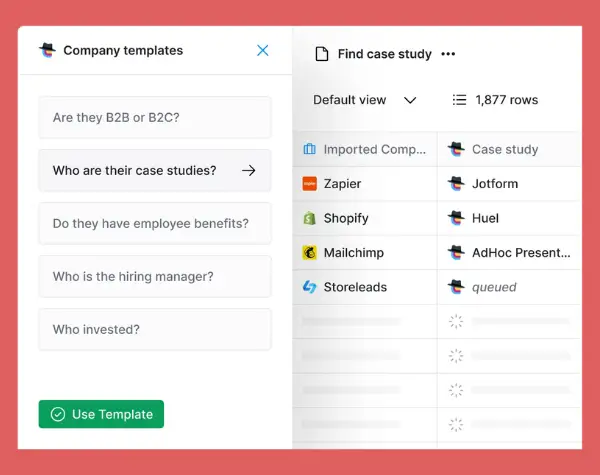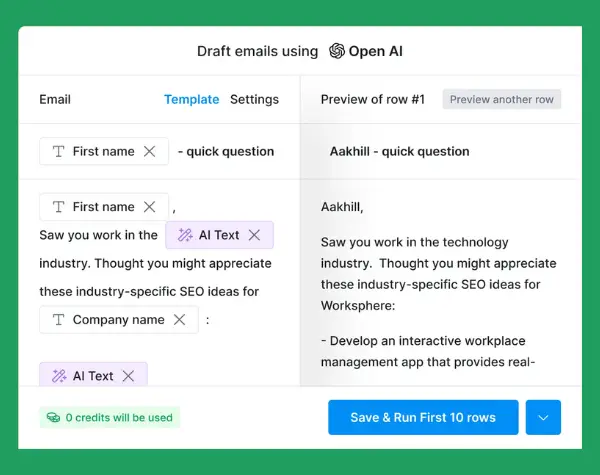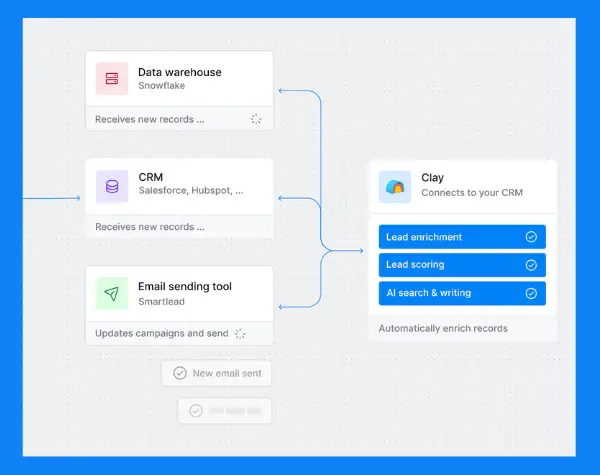The first GTM engineering agency
For B2B founders that want a small team but big revenue.
We engineer your GTM stack with AI & automation at its core—so you can double ARR without doubling headcount

“These guys are good”

If you’re a founder at an AI-native startup and you’re thinking through your GTM strategy, listen up…
GTM is at an inflection point.
Many of the GTM Advisors you’re speaking with cut their teeth on the old paradigm of scaling through a Capacity Plan.
I know this because I worked for them.
I also know you want the success of a Snowflake, Asana, or MongoDB but these companies are…
- Saddled with huge SDR and AE teams
- Plagued with incomplete and siloed GTM tools
- And their CRMs are a complete disaster
The result of this old playbook is “GTM Molasses”.
Which is why all of these companies are struggling with skyrocketing new logo acquisition costs.
Scaling through headcount is no longer acceptable.
On the other hand, AI SDRs are promising to completely replace your sellers.
There’s just one problem.
They don’t work.
And, it’s not because “the tech isn’t good enough yet.”
It’s because winning growth plays are temporary. They work because they are “pattern interrupts”.
No AI SDR company can move fast enough to “productionize” these plays before all the value is extracted out of them.
What’s left is an “AI personalization arms race”.
- Where the same data
- Sourced from the same data providers (Clearbit, ZoomInfo, Bombora, People Data Labs, etc)
…is personalized using the same foundation models (OpenAI, Anthropic, Meta).
And, the result is a deluge of “personalized” emails that are left to die unread in your spam folder.
There is a happy in-between though.
You can scale your GTM systems like software while keeping your team small & fast.
This new movement is called GTM Engineering.
GTM engineered systems look more like a unified development environment than the SDR/AE/RevOps “Factory Model” we have today.
The foundational tool making this possible is Clay.
With Clay, you can…
- Access any data provider without being locked-in
- Waterfall data providers against each other for the best data accuracy & coverage
- Use “Claygent” to automatically capture unique data points & signals
- Use JS formulas and conditionals to build complex workflows
- Use AI prompts to write N=1 personalized emails
But, Clay’s power comes with a steep learning curve.
And, there are other tools you need to integrate with it to get the most out of it.
A GTM Operating System is only as good as the GTM Engineers you have running it.
That’s where GTM6 comes in.
Skip the learning curve.
Future-proof your GTM stack.
And, most importantly…
Make GTM your moat by scaling it with software—not people.
Here's how we do it
Step 1
Build Your Unique Data Foundation
Unique data is your competitive advantage. Instead of blasting messages to all “SaaS companies with headcounts over 250” we find data like…
- Companies stuck in series B for over 3 years and hiring Account Executives
- Companies pursuing an M&A strategy
- Companies that have a PLG motion with usage-based pricing
- Companies in the cybersecurity space with large addressable markets
- Companies that have open prompt engineering roles
We aggregate these data points, create scoring models, and build bi-directional pipelines into your CRM so your data foundation is always up-to-date.

Step 2
Run GTM Experiments
Every great GTM team knows this one truth:
“What works today, won’t work tomorrow.”
- Personalized Loom videos
- Bumping an email with “Thoughts?”
- Annotated website screenshots
- GIFs & Memes
- Gift cards for demos
Were all blockbusters at one point
Ironically, a plays success is also its downfall. As more people copy, the play loses its “pattern interrupt” effect and it loses its efficacy.
You will not suffer from this problem.
Your GTM stack will let you find “GTM Alpha” because:
- You have unlimited access to new data providers
- You can build and test new plays quickly with automation
- You can scale winning plays with AI
Here’s what “fast moving” GTM teams are doing right…
A Software Security Company: Auto-generates personalized landing pages on Webflow for good-fit prospects, using individual company logos and information
An ABM Company: Identifies surging keyword bid prices on Google and automatically message companies on strategies to balance spend across LinkedIn and Meta.
A Hybrid Work Company: Finds new office announcements on Linkedin, checks if they 3+ open hybrid roles—sends personalized direct mail to Office Managers.
A Dev Tools Company: Monitors competitive Github repos for any negative comments or issues and automatically sends an email on how their product solves the problem.

Step 3
Automate Undifferentiated Work
Time kills all deals.
Automate undifferentiated work so your sellers can focus on deal acceleration tasks like…
- Champion building
- Multi-threading
- Business value case creation
- Executive alignment
Example pipelines that automate the grunt work away:
- Scrape calendar invites for all outside guests, enrich, and sync to CRM
- Ingest call transcripts to automatically find the name of mentioned Economic Buyers.
- Create meeting prep documents for your sellers before all inbound meetings
- Build an “always-on” ICP analysis that runs after every Closed-Won opportunity. Use the model to find look-a-like accounts
- Build a network graph of all of your employees and investors first degree connections. Use it build a “warm intro” list for each target account

Tactically, here's what you'll achieve in our first 90 days working together.
Month 1
Build Your Unique Data Foundation
- Technical setup: Email infrastructure, Clay, Apify, etc.
- Conduct internal/external customer research to determine common attributes among your best customers
- Find those data points and enrich accounts
- Create an account scoring model
- Find look-a-like customers
Month 2
Run GTM Experiments
- Identify two high ROI "micro campaigns" to test
- Build contact lists, enrich with email, phone, linkedIn, etc—sync to CRM
- Use AI to write n=1 personalized copy based on the campaign
Deliverable: Two campaigns launched into production. All responses managed through a unified inbox or through your reps inboxes.
*We can build call down lists for your reps to to work (queued into your SEP)
Month 3
Automate Undifferentiated Work
- Choose one manual workflow to fully automate. Popular options include:
- Automate inbound meeting prep for AEs
- Automate inbound lead follow-up
- Setup contact-level website visitor tracking and automate outreach
Deliverable: One manual workflow fully automated.

"And just like investors, winning GTM teams use data others don't have—in plays others can’t run—to find an edge."
Kareem Amin
Co-Founder & CEO – Clay
Book a 20-Minute GTM Teardown
Frequently asked questions
What is GTM Engineering?
GTM Engineering is new disciple emerging from elite GTM teams.
It is the practice of applying a software-engineering mindset—systems design, automation, rapid experimentation, and rigorous instrumentation—to every revenue-generating motion (marketing, sales, success, partnerships).
Instead of adding headcount, a GTM engineer builds and maintains scalable “revenue infrastructure” that turns ideas into repeatable, tech-powered workflows.
Is GTM Engineer just a rebrand of a Growth Marketer?
No.
A GTM Engineer is a bit of a unicorn.
They are more technical than RevOps. And, have more sales knowledge than a growth marketer.
While both care about new revenue, the difference lies in ownership.
Growth marketers think about channels and campaigns and rely on other teams for implementation.
Whereas a GTM Engineer thinks about repeatable systems and owns implementation end-to-end.
Quick litmus test to tell the difference:
- If the job is “turn on a new channel,” hire a growth marketer.
- If the job is “make every channel feel like software,” hire a GTM engineer.
Should I hire an agency or bring a GTM engineer in-house?
It’s a great question that is still open to debate.
Our experience suggests that Series C and beyond companies should be actively looking to bring a GTM Engineer in-house.
Seed – Series B companies are best suited to work with an agency as the skill set is rare and the time-to-hire is not worth the trade off in speed-to-market.
Will we own the systems your team builds?
Absolutely.
All clay tables, email infrastructure, domains, and additional email inboxes are owned by you.
You will be in complete ownership should you choose to stop working with us.
We create detailed operating documents to train your team on how to use what was buit.
How long is a typical engagement?
Typical engagements are six months in length.
There is usually an initial onboarding and systems build phase before moving into outbound campaigns.
What does pricing look like?
Pricing varies between retainer + pay for performance vs just a retainer.
Your current state and desired outcomes will dictate which is right for you.
For example, RevOps heavy work like CRM enrichment, ICP scoring, and workflow automation is usually retainer base only.
If we build outbound campaigns, pay for performance is typical.

